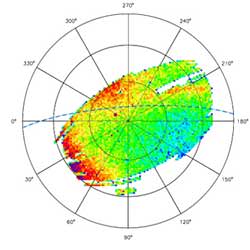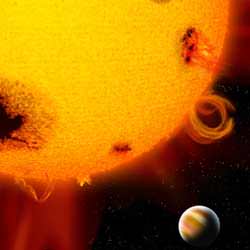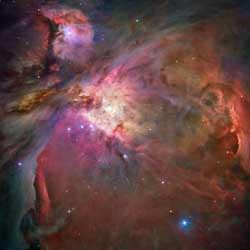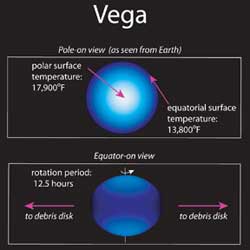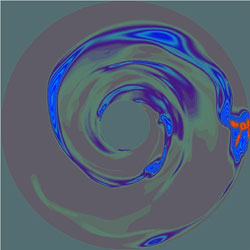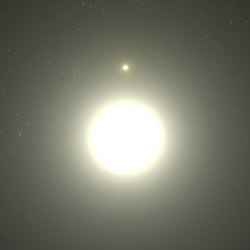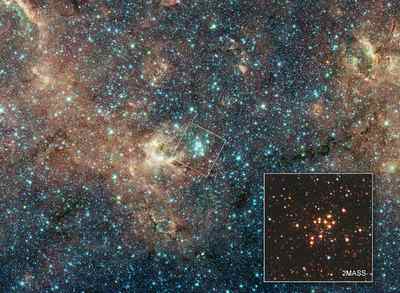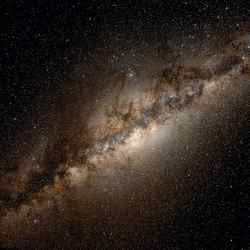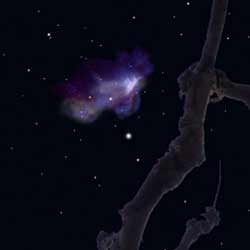
Future astronomers will see this nebula in the sky. Image credit: David A. Aguilar. Click to enlarge.
Astronomers announced today that they have found the next Orion Nebula. Known as W3, this glowing gas cloud in the constellation Cassiopeia has just begun to shine with newborn stars. Shrouds of dust currently hide its light, but this is only a temporary state. In 100,000 years – a blink of the eye in astronomical terms – it may blaze forth, delighting stargazers around the world and becoming the Grand Nebula in Cassiopeia..
“The Grand Nebula in Cassiopeia will appear in our sky just as the Great Nebula in Orion fades away,” said Smithsonian astronomer Tom Megeath (Harvard-Smithsonian Center for Astrophysics), who made the announcement in a press conference at the 207th meeting of the American Astronomical Society. “Even better, its home constellation is visible year-round from much of the northern hemisphere.”
The Orion Nebula is one of the most famous and easily viewed deep-sky sights. It holds special significance for researchers as the nearest region of massive star formation.
The star formation process begins in a dark cloud of cold gas, where small lumps of material begin to contract. Gravity draws the gas into hot condensations that ignite and become stars. The most massive stars produce hot winds and intense light that blast away the surrounding cloud. But during the process of destruction, stellar radiation lights up the cloud, creating a bright nebula for stargazers to admire.
“Orion may seem very peaceful on a cold winter night, but in reality it holds very massive, luminous stars that are destroying the dusty gas cloud from which they formed,” said Megeath. “Eventually, the cloud of material will disperse and the Orion Nebula will fade from our sky.”
Orion’s Trapezium
Of special interest to Megeath is a system of four bright, massive stars at the center of Orion known as the Trapezium. These stars bathe the entire nebula with powerful ultraviolet radiation, lighting up nearby gas. Even a modest telescope reveals the Trapezium surrounded by billowing ripples of matter gleaming eerily across the vastness of space. Yet the Trapezium is only the tip of the iceberg, surrounded by more than 1000 faint, low-mass stars similar to the Sun.
“The question we want to answer is: why are these massive stars sitting in the center of the cluster?” said Megeath.
There are two competing theories to explain the Trapezium’s location. One holds that the Trapezium stars formed apart from each other but descended to the center of the cluster, ejecting a spray of low-mass stars in the process. The other leading theory is that the Trapezium stars formed together in the center of the cluster and have not moved from their birthplace.
“Obviously, we can’t go back in time and look at the Trapezium when it was still forming, so we try to find younger examples in the sky,” explained Megeath.
Such proto-Trapeziums would still be buried in their birth cocoons, hidden to visible-light telescopes but detectable by radio and infrared telescopes. Searches at those longer wavelengths have identified many regions where massive stars are forming, but could not determine whether the protostars were alone or in collections of four or more stars that could be considered Trapeziums.
Cassiopeia’s Trapezium
Megeath and his colleagues examined one such protostellar clump in W3 using the NICMOS instrument on NASA’s Hubble Space Telescope and the National Science Foundation’s Very Large Array. They discovered that the object, which was thought to be a binary star, actually contained four or five young, massive protostars, making it a likely proto-Trapezium.
These protostars are so young that they appear to be still growing by accreting gas from the surrounding cloud. All of the stars crowd into a small area only about 500 billion miles across (just under one-tenth of a light-year), making this cluster more than 100,000 times denser than stars in the Sun’s neighborhood. This suggests that the massive stars in Orion’s Trapezium formed together in the center of the cluster.
The same physical processes that have carved the Orion Nebula now are molding the W3 nebula. The massive stars in this compact group are starting to eat away at the surrounding gas with ultraviolet radiation and fast stellar outflows. Eventually, they will destroy their dense cocoon and emerge to form a new Trapezium in the center of W3. However, the final form of the nebula and the time that it will reach maximum brilliance are uncertain.
“Who knows, in 100,000 years the emerging Grand Nebula in Cassiopeia may replace the fading Orion Nebula as a favorite object for amateur astronomers,” said Megeath. “In the meantime, I think it will be a favorite target for professional astronomers trying to solve the riddle of massive star formation.”
Megeath’s colleagues on this work were Thomas Wilson (European Southern Observatory) and Michael Corbin (Arizona State University).
Headquartered in Cambridge, Mass., the Harvard-Smithsonian Center for Astrophysics (CfA) is a joint collaboration between the Smithsonian Astrophysical Observatory and the Harvard College Observatory. CfA scientists, organized into six research divisions, study the origin, evolution and ultimate fate of the universe.
Original Source: CfA News Release

